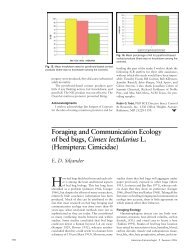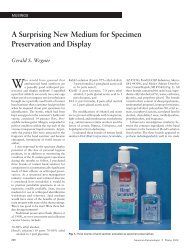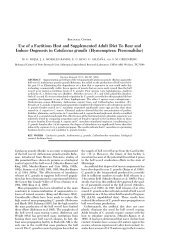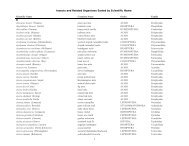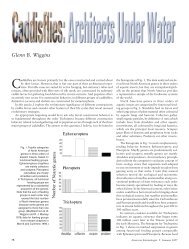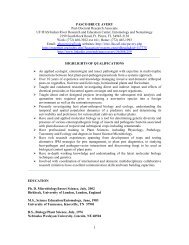Cold Tolerance of Four Species of Bark Beetle (Coleoptera ...
Cold Tolerance of Four Species of Bark Beetle (Coleoptera ...
Cold Tolerance of Four Species of Bark Beetle (Coleoptera ...
You also want an ePaper? Increase the reach of your titles
YUMPU automatically turns print PDFs into web optimized ePapers that Google loves.
June 2000 LOMBARDERO ET AL.: COLD TOLERANCE OF FOUR BARK BEETLES SPECIES 425<br />
Fig. 1. Seasonal patterns in the supercooling point <strong>of</strong> I.<br />
pini adults during winters <strong>of</strong> 1997Ð1998 and 1998Ð1999. Samples<br />
include beetles that were acclimated in soil microcosms<br />
at Þeld temperatures, in soil microcosms at a constant 0C,<br />
and within logs at 0C.<br />
0.003C/min and then warmed for 48 h at 22C and<br />
then measured with normal cooling rate: mean SE <br />
9.00 0.73 versus 7.70 1.69 versus 9.51 1.19,<br />
respectively (F 0.38; df 2, 39; P 0.68). Finally,<br />
mortality was not affected by cooling rates; there were<br />
no differences between the survival <strong>of</strong> I. pini adults<br />
cooled as slowly as 0.003C/min until 12.3C<br />
(mean supercooling point 1 SD) compared with<br />
beetles placed directly at 12.3 (5 <strong>of</strong> 18 versus 3 <strong>of</strong> 17)<br />
Fig. 2. Seasonal patterns in the supercooling point <strong>of</strong><br />
northern populations <strong>of</strong> I. grandicollis adults during winter <strong>of</strong><br />
1998Ð1999. Samples include beetles that were acclimated<br />
under Þeld conditions, and in soil microcosms at a constant<br />
0C.<br />
(G 0.52, df 1, P 0.47). For both treatments,<br />
mortality was indistinguishable from that expected<br />
based on the mean and standard deviation <strong>of</strong> supercooling<br />
points measured with the normal cooling rate<br />
<strong>of</strong> 0.20C/min ( 2 0.25; df 1; P 0.60).<br />
Long-Term Acclimation. There were no changes in<br />
the supercooling point <strong>of</strong> D. frontalis adults from the<br />
Þeld measured in October compared with those adults<br />
that were acclimated for 4 mo at 0C before measurement:<br />
mean SE 12.23 0.40 versus 12.85 <br />
0.42, F 1.12; df 1, 42; P 0.29). Apparently, D.<br />
frontalis can survive and slowly develop even at 0C,<br />
because there were individuals <strong>of</strong> all life stages alive<br />
after 4 mo at 0C. Similarly, southern populations <strong>of</strong> I.<br />
grandicollis showed no obvious acclimation after 6 wk<br />
at 0C: supercooling point (mean SE) <strong>of</strong> beetles<br />
measured in March from natural populations versus a<br />
subset <strong>of</strong> those beetles measured in May after 6 wk at<br />
0C versus another set <strong>of</strong> beetles collected from nature<br />
in May 12.24 0.76 versus 9.70 1.23 versus<br />
10.09 0.84 (F 2.48; df 2, 43; P 0.09).<br />
During 1997Ð1998, there were no differences in the<br />
supercooling points <strong>of</strong> I. pini adults in litter microcosms<br />
in the Þeld compared with those in litter microcosms<br />
in the incubator at 0C(F 2.31; df 1, 197;<br />
P 0.13 for main effect <strong>of</strong> environment; F 0.71; df <br />
2, 197; P 0.49 for date environment interaction;<br />
Fig. 1). There were differences in 1997Ð1998, but not<br />
in 1998Ð1999, between beetles overwintering in the<br />
microcosms in the Þeld and beetles overwintering in<br />
logs at 0C (1997Ð1998: F 69.82; df 1, 191; P <br />
0.0001 for main effect <strong>of</strong> environment and F 0.35;<br />
df 2, 191; P 0.70 for date environment interaction;<br />
1998Ð1999: F 0.36; df 1, 154; P 0.55 for<br />
effect <strong>of</strong> environment; F 0.66; df 3, 154; P 0.57<br />
for date environment interaction; Fig. 1).<br />
Southern and northern populations <strong>of</strong> I. grandicollis<br />
differed in their winter behavior when compared in<br />
common environments. Under greenhouse temperatures,<br />
the southern population colonized fresh logs<br />
within 1 wk during mid-December 1998, whereas<br />
northern populations <strong>of</strong> I. grandicollis and I. pini<br />
needed 1 mo before any individuals initiated galleries<br />
and began to oviposit. Larvae <strong>of</strong> southern populations<br />
survived for 7 wk in logs at 0C but appeared to completely<br />
cease development. At the same temperature,<br />
larvae from northern populations were able to develop<br />
slowly (the proportional abundance <strong>of</strong> larva:pupa:<br />
adults changed from 28:41:31 in November to 0:0:100<br />
in March). Southern populations did not survive Þeld<br />
temperatures in New Hampshire (minimum air temperature<br />
27C) and died in the logs without going<br />
to the soil; under the same conditions, northern populations<br />
entered the litter beneath the logs and largely<br />
survived (Fig. 3; chi-square comparing survival <strong>of</strong><br />
adults in Þeld versus greenhouse for Louisiana populations<br />
258.24, df 1, P 0.0001; same chi-square<br />
for Wisconsin populations 1.28, df 1, P 0.26).<br />
There were no signiÞcant differences in the supercooling<br />
point <strong>of</strong> beetles in the Þeld versus the greenhouse<br />
versus an incubator at 0C, although supercooling<br />
temperatures tended to be lower in Þeld



